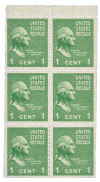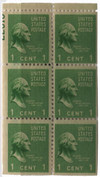U.S. #804b- booklet pane of 6
1938 1¢ Washington
Presidential Series
Issue Date: April 25, 1938
First City: Washington, DC
Quantity Issued: 20,804,006,500
Printing Method: Rotary press
Perforations: 11 x 10 ½
Color: Green
Known affectionately as the “Prexies,” the 1938 Presidential series is a favorite among stamp collectors.
The series was issued in response to public clamoring for a new Regular Issue series. The series that was current at the time had been in use for more than a decade. President Franklin D. Roosevelt agreed, and a contest was staged. The public was asked to submit original designs for a new series picturing all deceased U.S. Presidents. Over 1,100 sketches were submitted, many from veteran stamp collectors. Elaine Rawlinson, who had little knowledge of stamps, won the contest and collected the $500 prize. Rawlinson was the first stamp designer since the Bureau of Engraving and Printing began producing U.S. stamps who was not a government employee.
The 1¢ denomination pictures George Washington.
The “Father of our Country” – George Washington
1st U.S. President
The American people loved George Washington. His army officers would have made him king, if he had let them. Instead, he returned to Mount Vernon for five peaceful years. But, it wasn’t long before he was called again to serve his country, as the head of the Virginia delegation to the Constitutional Convention. After the United States Constitution was approved, Washington became the nation’s first President, winning all the available electoral votes. And when Washington was re-elected in 1792, he again received the highest-possible number of electoral votes.
President Washington successfully solved many of the problems of making the government established by the U.S. Constitution into a truly functional government. Washington believed the Constitution called for the branches of government to be kept separate. He felt the President should not attempt to influence the legislation passed by Congress – unless it was through presidential veto. Washington maintained that the presidency was for the administration of law and for maintaining relations with foreign nations.
After two terms, Washington retired to Mount Vernon. But he again served his country. On July 4, 1798, he was commissioned as “Lieutenant General and Commander in Chief of the armies raised and to be raised,” and asked to raise an army for the nation’s defense.
Washington died at Mount Vernon at the age of 67. In 1776, he was given the rank of General of the Armies of the United States, making him the highest-ranking officer in U.S. history. No other American is as honored as the “Father of our Country.” His portrait is featured on numerous postage stamps, the $1 bill, and the quarter. The capital and a state are named in his honor. The Washington Monument, a giant obelisk erected in his honor in Washington, D.C., was completed in 1880.










